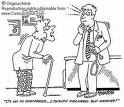|
Osteoporosis
One of the most serious problems caused by a calcium deficiency is osteoporosis, a condition characterized by the loss of 50 to 75 percent of the person's original bone material. In the U.S., 25 percent of 65-year-old women suffer from bone loss. Their bones become brittle and easily broken. They can crack a rib from something as minor as a sneeze.
Our pervasive dairy advertising has led us to believe the best way to build strong bones is to increase calcium consumption by drinking plenty of milk. This is WRONG!! Actually, the consensus among leading medical researchers is that the best way for most people to increase their calcium level and strengthen their bones is to: Research has conclusively shown we can do more to increase the calcium level in our bones by reducing protein intake than by increasing calcium intake. The reason is that animal products and other sources of high protein are very acidic, and the blood stream must balance this acidic condition by absorbing alkaline minerals such as calcium from the bone structure. VERY INTERESTING FACTS: Researchers have found that vegetarians have much stronger bones than meat-eaters.
Speaking of minerals, another serious problem caused by consumption of cow's milk is iron-deficiency anemia. 15 to 20 percent of children under age 2 in the U.S. suffer from iron-deficiency anemia. Cow's milk contributes to this condition in two ways. First, cow's milk is extremely low in iron, containing less than 1 milligram of iron per quart. Because of this, it is estimated that a 1-year-old would need to drink 24 quarts of cow's milk a day to meet his iron requirements, which would be impossible. Many infants may drink from one to two quarts of cow's milk a day, which satisfies their hunger to the point that they do no have the appetite to consume enough of other foods that do have a high iron content. This is just unbelievable. The second way that cow's milk leads to iron-deficiency anemia in many infants is a form of gastrointestinal bleeding caused by increased mucus and diarrhea associated with dairy consumption. According to Dr. Oski, Frank Oski, M.D., "It is estimated that half the iron-deficiency in infants in the U.S. is primarily the result of cow milk induces gastrointestinal bleeding,"

Did you know a woman's chances of suffering from an osteoporosis related fracture is greater than her risk of cervical, uterine and breast cancer combined?" It is a bone disease best described as "porous bones". Bones are living tissue, constantly being rebuilt. With osteoporosis, the rate of bone loss is greater than that of bone rebuilding, causing thin, porous bones that break easily. More than 28 million Americans have bone los or are at high risk of developing it. One in every 2 women and 1 in every 8 men will suffer bone loss-related fractures some time in their life. The national cost of osteoporosis and associated fractures is estimated at $10 billion and rising. Bone loss causes pain, disability, and loss of independence. However, it is treatable and the amount of bone loss can be prevented. Your bones develop in stages. From birth through adolescence, new bone is built faster than old bone is removed, so bones grow larger and denser. During adolescence, bones grow stronger at an even faster pace than before. Bone mass peaks between ages 20 and 30, then bone loss can outpace formation. After menopause in women, bone loss speeds up because of a loss in estrogen, a hormone that helps protect bones. The risk for osteoporosis increases if too little bone is formed during youth, or too much is lost later in life, or both. Size and quality of bone may be genetically determined, but other factors also influence bonehealth. A family history of osteoporosis or bone fractures, a lifelong low-calcium diet, Caucasian or Asian heritage, lack of exercise, low body weight relative to your height, smoking, drinking excess alcohol, lack of menstruation, and taking certain medications are all risk factors for bone loss. While you can't control all your risk factors, you can make lifestyle choices that will decrease your risk for developing osteoporosis. These include: eating a balanced diet rich in calcium, regularly doing weight-bearing activities, avoiding excessive alcohol, and not smoking. Building healthy bones at any age helps prevent osteoporosis later in life.

See Organic Milk and Breast Milk and Cow's Milk |



